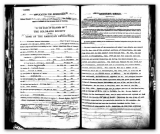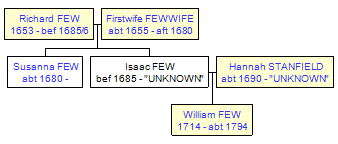Life History
before 1685 |
Born in Wales.1,2 |
after 27th Dec 1698 |
Married Hannah STANFIELD in Chester, Delaware, Pennsylvania.4 |
16th May 1714 |
Birth of son William FEW in Kenett Square, Chester, Pennsylvania.5,1,8,3,9 |
about 17th Jul 1794 |
Death of son William FEW in Columbia County, Georgia.5,6,7 |
UNKNOWN |
Death of Hannah STANFIELD in Pennsylvania |
UNKNOWN |
Died in Pennsylvania |
Notes
- U.S., Quaker Meeting Records, 1681-1935
Isaac Few
Hannah Stanfield
27 December 1698 Marriage Intention Announced to the meeting Delaware County, Pennsylvania
Minutes, Chester Monthly Meeting,Delaware County, Pennsylvania
Philadelphia Yearly Meeting
Family Data Collection - Individual Records
William Few
Spouse Mary Wheeler
Parents Isaac Few, Hannah Stanfield
Birth 16 May 1714 Chester County, Kennett Twp, Pennsylvania
Marriage Place:
Philadelphia, Philadelphia County, PA
Marriage 1742
Death 27 Jul 1794 Chester County, Pennsylvania
----------------------
Gregorys and Fews in Migration Patterns from the 1700s
By Orville Boyd Jenkins
Posted on Ancestry.com 16 October 2017
One factor in reconstructing a family lineage are patterns of movement and migration. These migration paths are helpful in finding and evaluating records in our Gregory and related Few line. We see Gregory records in a generational pattern along the migration streams along the tidewater area or valleys southwards and westward.
Westward
Records are being discovered in the westward line from Philadelphia through Frederick and Hagerstown, Maryland, through what is now West Virginia, still part of Virginia in the era we are looking at, and on to Ohio and Indiana. Brothers John, Richard and Benjamin Gregory, thought to be sons of Isaac Gregory of Pennsylvania, are mentioned several times in lists of residents of old Frederick County, Virginia, a large area at the northern end of the Shenandoah Valley, also on a common east-west migration route.
Records for a younger Richard Gregory are found in Culpeper County and Fauquier County, Virginia, on this westward path south of the Pennsylvania border. These two counties were established in 1749, cut out of Orange County, the original huge area from which Frederick County was originally established in 1743. These counties bordered Frederick County on the east.
Dates and locations of various records match a line of movement from the residence of Richard's likely grandfather Benjamin Gregory of Pennsylvania, into Frederick County, and later back to eastern Virginia in Prince William County, across the Potomac from Washington, DC. This westward line of migration connects with the great Shenandoah Valley running southwestward along the eastern edge of the Appalachian Mountains in what is now West Virginia.
Records for a Lewis Gregory, who appears to be a son of Benjamin, son of Isaac, are found along this Shenadoah Valley route then across into the part of Virginia that later became Kentucky, one of the areas where Fews and Gregorys come into contact. This matches the pattern of residence and Gregory-Few marriages in some of these areas along this southward line of migration. Details are found in individual notes for the Fews and Gregorys. Gregorys from this lineage moved westward a bit to the part of Virginia that is now northern Kentucky.
Southward
Gregorys are found along the Shenandoah Valley which runs southwestward from Hagerstown to Bristol, Virginia/Tennessee, on the border, on through Jefferson and Cocke County, which were all one area of North Carolina, then East Tennessee (current I-81 to I-40 to Knoxville) in the 1700s and early 1800s and on toward Cherokee and contiguous counties in Alabama.
We find Gregorys that appear to be from two different lineages who followed the Shenandoah or similar route from Philadelphia-Baltimore through Virginia into Tennessee, our line through the easterly route of the named east Tennessee counties, the other a bit more westerly, with members of both lines in Kentucky.
These two lines seem to be connected to the same line from Pennsylvania and northern Virginia. But there are indication of one or two separate migration streams in the same areas. Early sources are not clear on these lines, and similar names in what may be different lineages seem to have been confused in some genealogies.
I have been through all these areas and explored these lines of migration so have these in mind as I read through records and watch for connections and clues.
Westward Ho
Gregorys in the line of James Henry Gregory and Rachel Lewis are found in those counties of Tennessee from Jefferson-Cocke on to Knox, McMinn (where we find both these Gregorys, with apparently no crossover), Franklin, etc, in the westward migration route. Gregorys of our lineage also seem to have moved northwestward through the mountain passes toward Louisville.
Fews and Gregorys are connected in the states of Virginia, Kentucky (which was originally part of Virginia colony), North Carolina and Tennessee (which was originally part of North Carolina Colony) in several generations. The Fews in North Carolina apparently followed the westerly route over the Smokies into Tennessee into Jefferson County, Tennessee, and surrounding counties where they connected again with the Gregory lineage. We find them in the family of Francis Marion Few from North Carolina Jefferson County, Tennessee, where his daughter Letha married Andrew Jackson Gregory, my great great grandfather's brother.
Crossflow
Traffic went both ways along those Midwestern routes over a period of two centuries. Fews moved into the Louisville, Kentucky, area from Indiana (across the Ohio River. Gregorys and Fews also moved from eastern Tennessee into Kentucky.
Great migrations northward occurred in the 1920s and later because of extensive floods along the Mississippi, destroying much of the Delta South. The depression added to this exodus northward. Midwestern droughts accelerated movement to California. Further industrialization in the next two decades and after WWII accelerated this migration northward and westward.
The geographical indicators are not only contiguous counties, but similarly in the counties along these common natural migration routes, which also reveal patterns of the same family decade to decade and generation to generation. These patterns match the same kinds of patterns we find in ethnic investigations all over the world.
----------------------
Page created using GEDmill 1.11.0



